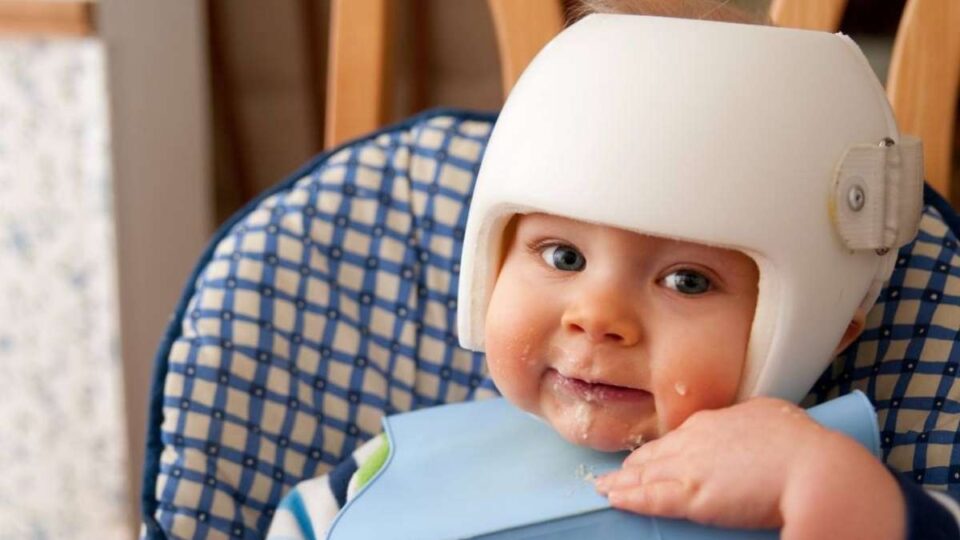A cranial helmet, called a Boston Band, treats deformational plagiocephaly or flat head syndrome. It works by restricting further asymmetric growth and encouraging the existing flat areas to grow into space in a more normal, rounded shape.
Westcoast Brace & Limb helmet specialist orthotic clinic is certified to design and fit your infant with the leading cranial helmet. We begin with a scan and provide you with a personal treatment plan.
What is cranial remolding?
Cranial remolding, also known as helmet therapy, treats deformational plagiocephaly and brachycephaly in infants. The condition results in flattened areas of the front or back of an infant’s head and is most common during the first three months of life.
In many cases, it results from the baby spending much time in one position in the womb, twins taking up extra space, or low amniotic fluid levels. In other cases, it can be caused by a condition known as craniosynostosis, which is the premature fusion of the skull bones.
The helmets at Westcoast Brace & Limb are preferred for treating cranial asymmetry. They are FDA-cleared and be effective in reducing cranial asymmetry in many studies. They are a safe and effective treatment option combined with repositioning strategies, physical therapy, and tummy time. The band is made through 3D shape capture technology (a particular scanner). The custom fit allows it to restrict further asymmetric growth while guiding the skull into a more normal rounded shape.
How does cranial remolding work?
A cranial helmet, also known as a cranial band or cranial remolding orthosis, redirects the growth of an infant’s skull. It does so by gently but consistently putting pressure on your child’s head to change shape. The helmet treats severe positional plagiocephaly (flattening on one side of the head) and brachycephaly.
A helmet will hold the areas of your baby’s skull that are full or prominent and leave open space over the flattened areas. This encourages the flattened area to grow into the open space of the helmet, allowing the skull to form a rounder and more even/symmetrical shape.
Westcoast Brace & Limb uses a band successfully treating deformational plagiocephaly, brachycephaly, and scaphocephaly. Unlike traditional helmets, the band does not have a “hard shell,” making it more comfortable to wear for long periods. It is essential to start treatment early, between 3 and 18 months of age, to make the most of your infant’s rapid brain growth rate.
What are the benefits of cranial remolding?
The band is used to treat a variety of head shape abnormalities, including deformational plagiocephaly (flattening of the skull) and brachycephaly (thickness of the crown). It can also be used in cases of congenital craniosynostosis, where the plates of the baby’s skull fuse prematurely.
It is essential to begin helmet treatment as early as possible because the skull’s growth rate is highest in the first year of life. The earlier treatment begins the more dramatic the results.
A study by Graham et al. found that the most effective time to start cranial molding helmet treatment is when the asymmetry index is lower than or equal to 4. This means it is most beneficial for babies to begin treatment by four months of age. After six months of age, it is more difficult to achieve positive outcomes because the skull has finished growing and has less elasticity for plasticity. This is why Hanger Clinic only treats plagiocephaly for up to 18 months.
What are the risks of cranial remolding?
If your child is diagnosed with positional plagiocephaly (flat spots on the side of the head), brachycephaly, or scaphocephaly, cranial remolding may be recommended. These helmets are custom-made using a plaster cast or a 3D shape capture system and provide an even space for your infant’s head to grow into.
The cranial remolding process does not cause any harm to your infant. It is an effective and conservative treatment option for positional skull deformities, as opposed to surgery.
The band is FDA-cleared for use to treat a variety of deformities. It best treats positional plagiocephaly, brachycephaly, and scaphocephaly in babies from birth to 18 months. It also helps manage a few forms of craniosynostosis in patients who have closed sutures and do not need surgery. However, surgery is a better treatment for open sutures and severe cases of craniosynostosis, so we recommend seeking a consultation with an orthopedic surgeon.

